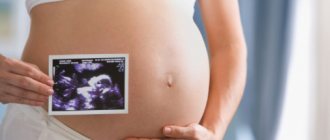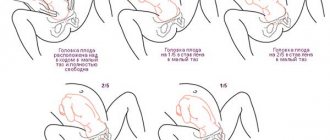What happens in the 1st trimester of pregnancy
The first two weeks of obstetric pregnancy are the preparation of the body for possible conception and the creation of conditions for the attachment of the embryo in the uterine cavity. These changes occur during each menstrual cycle.
Calculations start from the first day of the last menstruation. During this period, there is a sharp decrease in the levels of progesterone and estradiol produced by the corpus luteum. Since the corpus luteum undergoes involution by the time menstruation begins, the level of these hormones also declines. This leads to the detachment of the endometrium, a special mucous tissue rich in blood vessels that protrudes from the inside of the uterus.
The body then enters the follicular phase of the ovarian cycle. At the same time, the amount of FSH in the blood increases. This hormone is responsible for the maturation of the egg, as well as increasing the thickness of the new endometrial layer. This continues until ovulation occurs, the moment when an egg is released from a mature follicle into the abdominal cavity. At the same time, the amount of LH and FSH in the blood increases sharply, and the endometrium has a maximum thickness of 13-14 mm.
Then, in place of the follicle with the egg, the corpus luteum is formed - an endocrine gland that produces progesterone and estradiol. These are the main pregnancy hormones. The development of the corpus luteum occurs with the participation of luteinizing hormone of the pituitary gland (LH).
After implantation in the uterine cavity, the embryo begins to produce its own hormone, hCG, on the detection of which pregnancy tests are based. HCG levels increase exponentially. At the same time, the concentration of progesterone and estradiol in the blood increases due to the active development of the corpus luteum. Its growth will continue for about 2 months, after which the function of this gland will be taken over by the placenta.
Fetal development in the 1st trimester of pregnancy
During ovulation, the oocyte enters the abdominal cavity, where it is picked up by a current of fluid. Thanks to the peristalsis of the villi of the fallopian tubes, it penetrates into their cavity. There fertilization occurs, which is possible within 24 hours from the moment the egg leaves the follicle. The new embryo moves through the fallopian tube with a flow of fluid, according to the movements of the cilia of the epithelial lining of the tubes.
The first days after conception
After pregnancy occurs, the embryo's cells move through the fallopian tubes for about 3-5 days. All this time they divide, and receive nutrition from the “reserves” of the oocyte. The genome of the newly created embryo does not yet function. From 3-4 days, the first critical period is observed - this is the time of activation of the embryo’s genome, if it fails, the pregnancy can terminate spontaneously.
At this stage, the cells do not increase in size and form a compact structure - a morula. After the morula is represented by 32 cells, a cavity appears in the center of it, and the morula itself turns into a blastula.
Gastrulation
After passing through the fallopian tubes, the embryo reaches the uterine cavity, and the second critical stage of its development begins - implantation into the thickness of the endometrium. Early gastrulation begins (7-14 days). The cells of the blastocyst separate and migrate, forming the outer layer - the trophoblast (epiblast) and the layer responsible for the formation of the amnion and yolk sac (hypoblast).
Trophoblast cells duplicate, and it begins to play a key role in embryo implantation. Under the action of its enzymes, part of the endometrial wall is destroyed, and the embryo is placed in this cavity. At this stage, the embryo is nourished by endometrial lysis products - histiotrophic nutrition. After the trophoblast comes into contact with the endometrial vessel, the hematotrophic type of nutrition is established - now the embryo will receive nutrients from the mother’s blood.
In parallel, other provisional organs are formed - the amnion, yolk sac and allantois. In place of the trophoblast, chorionic villi subsequently quickly form. They will grow into the thickness of the uterus, performing the functions of the placenta throughout the first trimester.
Between these formations there remains one row of cells - the germinal disc. Its cells, migrating, give rise to three germ layers. They are called ectoderm, endoderm and mesoderm. The following organs emerge from them:
- from the ectoderm - skin, hair and nails, the nervous system of the fetus, notochord (the axis of the embryo and the predecessor of the spine);
- from the endoderm - all internal covers of organs, including the gastrointestinal tract;
- The mesoderm will give rise to muscles, bones, parenchyma of internal organs, connective tissue, and dermis of the skin.
Neurulation
Starting from day 19, neurulation occurs - the formation of the neural tube of the embryo. This is an important stage, since the further state of the baby’s nervous system depends on the usefulness of this rudiment.
In parallel, from the 20th day of intrauterine development, the division of the body into somites begins. The mesoderm forms the rudiments of the skin, skeleton and muscles (dermatome, sclerotome, myotome). Division into somites occurs within 20-22 days. They appear segment by segment.
Organogenesis
Organogenesis is the formation of each organ directly by the rudiment. The process is based on clonal theory. That is, each cell of the embryo is first divided into a certain number of clones that do not have strict signs of “specialization.” And then they begin to divide, acquiring structures and features characteristic of their organ.
The location of the cells is of fundamental importance. It is believed that a powerful factor determining the purpose of cells is the embryonic induction inherent in the mesoderm and its derivatives.
Further development of the embryo by week
| 3 weeks | The baby develops small arms and legs. It already has body symmetry, and it has a small semblance of a “tail”, which is further reduced. While its arms are longer than its legs, they do not have fingers. |
| 4 weeks | The baby's heart begins to form. It already has 4 cameras, but they are all placed linearly. During this period, gill arches are formed - 5 pairs of formations, which, fused in a special way, form the facial part of the embryo's skull. Language is formed from them. Improper fusion of the gill arches leads to the appearance of clefts in the face (“cleft lip”) or palate (“cleft palate”). |
| 5 weeks | A prototype of the mouth is formed - the oral bay. Initially, it has no connection with the intestinal tube. |
| 7 weeks | The baby develops thickening of the skin in the area of the mouth. They sink deep into the underlying tissues, and from them the rudiments of the child’s milk and permanent teeth are subsequently formed. At this stage, the nephrotome forms primary structures characteristic of the intermediate stage of the formation of the urinary system - mesonephros. These are tubes ending in Malpighian bodies. They flow into a single channel located along the entire body. Mesonephros are similar to the excretory system of fish and amphibians. It is replaced by a metanephros - a compact formation in which tubes with Malpighian bodies are grouped in one place and flow into the Wolffian canal. Its outgrowth becomes the predecessor of the ureter. |
| 8 weeks | The heart completes its formation. Now its chambers are located in the correct order, however, some signs characteristic of the immaturity of this organ persist until the 3rd trimester. They are needed to adapt the fetus to intrauterine life. |
Visit to the gynecologist
By and large, the first visit of a pregnant woman to a gynecologist is not much different from a standard examination. To confirm pregnancy, the doctor will examine the vagina using a speculum and palpation. During the process, he will take a smear on the flora and draw the necessary conclusions about the general condition of the uterus, its cervix, appendages and the vagina as a whole. In the future, such inspections will no longer be carried out. The gynecologist will limit himself to palpating the abdomen on the couch.
Also, in the early stages of pregnancy, ultrasound will help to identify it more accurately, with the help of which you can also determine the exact date.
On the couch, the gynecologist will additionally take measurements of the pelvis and waist. Then you will need to weigh yourself and determine the woman’s height. Blood pressure is also measured in both arms.
All data will be entered into an exchange card, which will be given to the pregnant woman after the first examination. Notes will be added there about the state of health, the presence of various types of chronic diseases, injuries, illnesses, operations that took place in the life of the woman and her immediate family.
You need to be prepared for the doctor to ask questions about the first period, about the beginning of sexual activity, and he also needs to know about the bad habits and lifestyle of a pregnant woman. All this is not the doctor’s idle curiosity, but important and necessary data that will help determine the general state of health and predict the course and development of pregnancy.
Important! There is no need to be shy and hide from the gynecologist facts about your health that you might not want to advertise. The specialist will definitely keep your secret, but will have information about the possible causes of pregnancy complications. Prepare for your visit to the doctor, be prepared to talk clearly and specifically about yourself.
After all of the above, the nurse or the doctor himself writes out the woman’s directions for the necessary examinations and tests that will need to be taken in the near future.
Usually, at the first visit, the doctor recommends the use of vitamins or other medications that help adjust hemoglobin levels and increase the amount of microelements necessary for pregnancy.
Tests and examinations in the 1st trimester of pregnancy
The most important moments of the first trimester are the diagnosis of pregnancy using reliable criteria and the first screening.
There are tests and clinical manifestations that can only indirectly indicate pregnancy. Among them:
- pregnancy test;
- cyanosis of the cervix upon visual examination (can also be 1-2 days before the onset of menstruation);
- change in a woman's condition.
A pregnancy test can give a false positive result. This is possible due to the oncological process of the uterus, adrenal glands or the onset of biochemical pregnancy. It is spontaneously interrupted before the implantation stage, after activation of the failed genome of the embryo.
A reliable sign of pregnancy is the presence of a fertilized egg in the uterus, which is determined by ultrasound from the 3rd week of obstetric pregnancy. This indicates that the first critical stage has been passed and the embryo has settled in the uterine cavity.
After establishing the fact of pregnancy, a woman is prescribed a number of examinations:
- General analysis of urine and blood.
- Biochemical tests.
- Coagulogram.
- Determination of blood group and Rh factor.
- Tests for infections (HIV, viral hepatitis, syphilis).
- Vaginal smear to detect pathogenic flora (chlamydia, Candida fungi, mycoplasma and ureaplasma).
- Tests for the group of TORCH infections - herpes virus types 1 and 2, cytomegalovirus (herpes type 5), toxoplasmosis, rubella.
The first screening is carried out for the early detection of severe anomalies and malformations, as well as genetic abnormalities in the fetus. Duration: from 10 to 14 weeks of pregnancy. The examination consists of 2 components: a blood test for hormone levels (beta subunits of hCG and PAPP) and an ultrasound, during which the doctor:
- determines the fetal heart rate;
- determines the main dimensions: coccygeal-parietal, biparietal, etc.;
- assesses the condition of the fetal facial skull for the presence of facial clefts;
- determines the thickness of the collar space, which may be an indicator of genetic abnormalities;
- the length of the femur determines the exact duration of pregnancy (along with other signs) and the presence of genetic pathologies;
- establishes the exact gestational age, determines the correspondence of the level of fetal development to the gestational age;
- assesses the state of organs (for example, the pairing and symmetry of the cerebral hemispheres).
The conclusion of a screening ultrasound is usually issued on A4 sheets, where all the relevant parameters are written down.
Healthy Habits
It looks like the need to gain weight is just a myth: you don't have to eat for two. It is enough to add only up to 300 calories to your daily diet (a little more if you have a multiple pregnancy). As your pregnancy progresses and your physical activity decreases, you may not even need all those calories.
However, weight gain is a sign of healthy growth, and restricting calories can cause the baby to be underweight or premature. Strict diets are dangerous for a baby because they deprive him of important vitamins and minerals. As they used to say: we gain 9 months, we lose 9 months? Follow this wisdom. Focus on a balanced diet rich in fruits and vegetables, protein, and moderate carbohydrates.
Pregnancy in numbers:
- underweight women should gain 13-18 kg;
- women with normal weight - 11-16 kg;
- overweight women - 7-11 kg;
- women pregnant with twins - 16-20 kg.
But we are all different. Most women gain 2-7 kg in the first half of pregnancy, and then about 0.5 kg per week from the 20th to the end of the term. In the first trimester, these numbers can be very different from the average due to increased hormone levels and appetite. Many will stay at their weight or even lose some due to nausea, vomiting and decreased appetite. If you are drinking enough fluids and your baby is growing normally, rest assured that your baby will take what he needs and you may still have some weight to gain.
If you have gained too much weight, your doctor may suggest that you be tested for possible hormonal imbalances, diabetes, and thyroid disease. Mother Nature is a smart investor, so even moms with chronic illnesses should expect good results.
Consultation with a gynecologist . Expectant mothers often complain that they eat the same amount of food and exercise a lot, but still gain weight. I remind them that most of it is liquid. During pregnancy, the body turns into a sponge. My patients try to exclude foods high in salt from their diet, because... it absorbs water. Once you indulge in Chinese food or pizza, you may notice a surprising change in your weight. Don't be alarmed - these are just tricks of your body trying to achieve balance.
Nutrition in the 1st trimester of pregnancy
The mother’s lifestyle plays a key role at this stage of the baby’s development, because right now the formation of all organs and systems of the fetus occurs. Therefore, special attention should be paid to nutrition.
The number of calories per day and diet may be the same, but all foods with food additives should be avoided. That is, you should eat only home-cooked food without spices or flavor enhancers.
Preference should be given to steamed and baked foods, reducing the consumption of fried and fatty foods.
There are no special nutritional needs or recommendations during this period. However, consuming dark red vegetables and fatty fish will be beneficial. These foods are rich in folic acid and healthy fats for the development of the child's nervous system.
Basic recommendations
The most important tips for expectant mothers in the first trimester of pregnancy are as follows:
- First of all, you need to get rid of all bad habits if the expectant mother previously smoked or drank alcoholic beverages. Any dangerous toxic substances during this period are very harmful to the fetus, so no imaginary pleasure from their use should outweigh the health of the unborn child.
- Almost all medications are also prohibited, even those that can be purchased without a prescription. It is unacceptable to take any medications, even seemingly safe ones, without consulting a doctor, who should be informed about your pregnancy.
- The developing fetus needs sufficient nutrients, so the expectant mother should regularly eat fruits, vegetables, dairy products, meat and fish. But sweets need to be limited, because almost all of them do not contain anything useful, only extra calories.
- Since the first trimester is a rather critical period for the embryo (fetus) and at this time there is a possibility of miscarriage, you should refrain from intimate relationships at this time.
- Excessive physical activity should be avoided and the level of usual physical activity should be somewhat limited in order to protect yourself from a possible miscarriage or any complications.
- If possible, you should avoid visiting crowded places, as this can cause you to become infected with infectious diseases, which at this stage are especially dangerous for the developing fetus.
- You can take vitamins as prescribed by your doctor, who will advise how much additional nutrients your baby needs.
An exact list of recommendations about what can and cannot be done in the first months of pregnancy can be obtained from an antenatal clinic specialist who can take into account the woman’s health condition and the available examination results. For more information, watch the video on the topic.
The first trimester of pregnancy is a real test not only for the expectant mother, but also for the rest of the family. It is at this time that a woman needs the help and support of family and friends more than ever. But there is no need to worry unnecessarily about the health of the unborn baby, because nature itself provides that the baby will develop in the most optimal way, provided that the expectant mother avoids exposure to harmful environmental factors and is tuned in to a successful pregnancy outcome. In this case, the first trimester of pregnancy will become one of the happiest and most exciting periods of a woman’s life.









